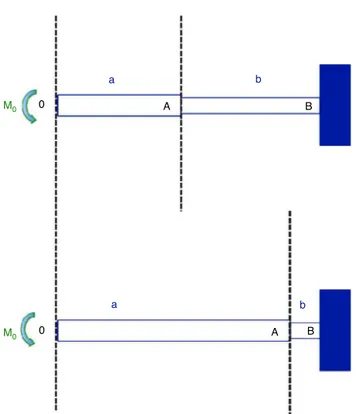SOCIEDADE BRASILEIRA DE ORTOPEDIA E TRAUMATOLOGIA
w w w . r b o . o r g . b r
Technical
Note
Finite
element
analysis
of
the
equivalent
stress
distribution
in
Schanz
screws
during
the
use
of
a
femoral
fracture
distractor
夽
Vincenzo
Giordano
a,∗,
Alexandre
Leme
Godoy-Santos
b,
William
Dias
Belangero
c,
Robinson
Esteves
Santos
Pires
d,
Pedro
José
Labronici
e,
Hilton
Augusto
Koch
faHospitalMunicipalMiguelCouto,Servic¸odeOrtopediaeTraumatologiaProf.NovaMonteiro,RiodeJaneiro,RJ,Brazil
bUniversidadedeSãoPaulo,FaculdadedeMedicina,HospitaldasClínicas,SãoPaulo,SP,Brazil
cUniversidadeEstadualdeCampinas,DisciplinadeOrtopediaeTraumatologia,Campinas,SP,Brazil
dUniversidadeFederaldeMinasGerais,DepartamentodoAparelhoLocomotor,BeloHorizonte,MG,Brazil
eUniversidadeFederalFluminense,DepartamentodeOrtopediaeTraumatologia,Niterói,RJ,Brazil
fUniversidadeFederaldoRiodeJaneiro,FaculdadedeMedicina,DepartamentodeRadiologia,RiodeJaneiro,RJ,Brazil
a
r
t
i
c
l
e
i
n
f
o
Articlehistory: Received16June2016 Accepted20June2016 Availableonline24July2017
Keywords:
Finiteelementanalysis Bonenails
Femoralfractures Externalfixators Treatmentoutcome
a
b
s
t
r
a
c
t
Toevaluatethemechanicalstressandelasticdeformationexercisedinthethread/shaft transitionofSchanzscrewsinassemblieswithdifferentscrewanchoragedistancesinthe entrancetothebonecortex,throughthedistributionandlocationoftensioninthesamples. Ananalysisof3Dfiniteelementswasperformedtoevaluatethedistributionofthe equiv-alentstress(triplestressstate)inaSchanzscrewfixedbicorticallyandorthogonallytoa tubularbone,usingtwomountingpatterns:(1)thread/shafttransitionlocated20mmfrom theanchorageoftheSchanzscrewsintheentrancetothebonecortexand(2)thread/shaft transitionlocated3mmfromtheanchorageoftheSchanzscrewsinentrancetothebone cortex.Thesimulationswereperformedmaintainingthesamedirectionofloadingandthe samedistancefromtheforcevectorinrelationtothecenterofthehypotheticalbone.The loadapplied,itsdirection,andthedistancetothecenterofthebonewereconstantduring thesimulationsinordertomaintainthemomentofflexionequallyconstant.Thepresent calculationsdemonstratedlinearbehaviorduringtheexperiment.Itwasfoundthatthe modelwithadistanceof20mmbetweentheSchanzscrewsanchorageintheentranceto thebonecortexandthethread/shafttransitionreducestheriskofbreakageorfatigueof thematerialduringtheapplicationofconstantstaticloads;inthismodel,themaximum forcesobservedwerehigher(350MPa).ThedistancebetweentheSchanzscrewsanchorage attheentrancetothebonecortexandthesmooththread/shafttransitionofthescrews usedinafemoraldistractorduringacutedistractionofafracturemustbefartherfromthe
夽
StudyconductedattheDepartamentodeOrtopedia,HospitalMiguelCouto,RiodeJaneiro,RJ,Brazil,andattheDepartamentode OrtopediaeTraumatologia,FaculdadedeMedicina,UniversidadedeSãoPaulo,SãoPaulo,Brazil.
∗ Correspondingauthor.
E-mail:vgiordano@me.com(V.Giordano). http://dx.doi.org/10.1016/j.rboe.2017.07.003
Ltda.ThisisanopenaccessarticleundertheCCBY-NC-NDlicense(http:// creativecommons.org/licenses/by-nc-nd/4.0/).
Análise
de
elementos
finitos
da
distribuic¸ão
de
tensões
equivalentes
nos
pinos
de
Schanz
durante
o
uso
do
distrator
femoral
de
fraturas
Palavras-chave:
Análisedeelementosfinitos Pinosortopédicos
Fraturasdofêmur Fixadoresexternos Resultadodotratamento
r
e
s
u
m
o
Avaliar ocomportamento doestresse mecânicoe da deformac¸ão elástica exercida na transic¸ãorosca-talolisodospinosdeSchanzdodistratorfemoraldefraturasemmontagens comdiferentesdistânciasdeancoragemdospinosnacorticalósseadeentradaatravésde estudodadistribuic¸ãoedalocalizac¸ãodetensõesnocorpodeprova.
Feitaanálisedeelementosfinitos3Dparaaavaliac¸ãodadistribuic¸ãodastensões equiv-alentesemumpinodeSchanzfixadodemodobicorticaleortogonalaumossotubular, emdoispadrõesdemontagem:(1)transic¸ãorosca-talolisodistante20mmdaancoragem dospinosdeSchanznacorticaldeentradae(2)transic¸ãorosca-talolisodistante3mmda ancoragemdospinosdeSchanznacorticaldeentrada.Foramfeitassimulac¸õese manteve-seamesmadirec¸ãodacargaeamesmadistânciadovetorforc¸aemrelac¸ãoaocentrodo ossohipotético.Acargaaplicada,suadirec¸ãoeadistânciaaocentrodoossoforam con-stantesduranteassimulac¸õesparamanteromomentofletorigualmenteconstante.Os cálculosapresentadosdemonstraramcomportamentolineardurantetodooexperimento. Verificou-sequeomodelocomumadistânciade20mmentreaancoragemdospinosde Schanznacorticalósseadeentradaeatransic¸ãorosca-talolisoreduziuoriscoderuptura oufadigadomaterialduranteaaplicac¸ãodecargasestáticasconstantes.Nessemodelo, asforc¸asmáximasobservadasforamsuperiores(350MPa).Aanálisedocomportamento doestressemecânicoedadeformac¸ãoelásticaexercidanatransic¸ãorosca-talolisodos pinosdeSchanzdodistratorfemoraldefraturasmostrouquedistânciasmaioresentrea ancoragemdospinosnacorticalósseadeentradaeatransic¸ãorosca-talolisodospinos deSchanzpermitemmenorestressemecâniconatransic¸ãorosca-talolisoemaiorgraude deformac¸ãoelásticadomaterialeminimizamquebraoufadiga.Adistânciasugeridaéde 20mm.
©2016SociedadeBrasileiradeOrtopediaeTraumatologia.PublicadoporElsevier EditoraLtda.Este ´eumartigoOpenAccesssobumalicenc¸aCCBY-NC-ND(http:// creativecommons.org/licenses/by-nc-nd/4.0/).
Introduction
Inthemanagementofvariousorthopedicsituationsrelated totrauma,suchasdiaphysealfracturesoflongbonesofthe lowerlimbsandconsolidationdisorders,theuseofindirect reduction tools such as femoral fracture distractor, devel-oped by the AO Group1 to be used as an adjuvant tool for fracture alignment, is an important advantage during surgery.Itsapplicabilitygoesbeyondthegainoflength dur-ingsurgery;itispossibletomakesimultaneousorisolated angularandrotationalcorrections.Afterthedesired adjust-ments,itservestomaintainthebonefragmentsinposition until definitive osteosynthesis is achieved. Several studies havedemonstrateditsapplicationinhighlyvariedsituations oforthopedictrauma.2,3
Accordingtothe techniqueused,the fixationofSchanz screws–oneinthemainproximalfragmentandanotherin themaindistalfragment,perpendicularlytothelongaxisof
theoperatedbone–allowsthedistractor’sthreadedbodyto bepositionedparalleltothebone.Protectivesleevesareslid overthescrewsforbothbiologicalandmechanicalprotection atthesofttissue-pin-boneinterface.Duringdistractionofthe fractureline,pseudoarthrosis,orosteotomy,thehigheststress isobservedinthe corticaladjacent totheentry siteofthe pins,whichisalsotheareaofgreaterfrequencyoffailureand loosening.4
0
0
A
A
a b
a b
B
B M0
M0
Fig.1–Diagramsusedfortheanalysisoffiniteelementsof thedistributionofequivalentstresses.
A,shaft;b,thread;F0,initialflexionmomentum;1A-M1,
thethread/shafttransitionisdistanced20mmfromthe entrancetothecorticalbone;1B-M2,thethread/shaft transitionisdistanced3mmfromtheentrancetothe corticalbone.
areinsertedmanuallyuntilthethreadisfixatedthroughthe cis(input)andtrans(opposite)corticalboneandtheshaftis fullysupportedintheciscortical.9
Thepresenthypothesiswasthatthesmallerthedistance between the thread/shaft transitionand the Schanz screw anchorage point in the entrance to the cortical bone, the greaterthemechanicalstressgeneratedinthetransition,and thereforethegreatertheriskofruptureorfatigue.
Thepresentstudywasdesignedtoevaluatethe distribu-tionofmechanicalstressandtheelasticdeformationofthe materialintheSchanzscrewsduringagradualdistractionin mountingswithdifferentanchorlengthsintheentranceto thecorticalbone,assessingthedistributionandlocationof thestressesinthetestspecimen.
Methods
Studydesign
AfterInstitutional Review Boardapproval, under the num-ber0347-2015, a3Dmonobody finiteelement analysiswas performedtoassessthedistributionoftheequivalentstress (triplestressstate)inaSchanzscrewfixatedtoa hypotheti-caltubularbone.Thebonemodelusedwasvirtuallymapped fromalongbone,initsdiaphysealportion,throughafinite elementcomputationalstudy.
0
M0 = -Fa
x
Fig.2–Constructionoftheflexion-momentumdiagram.
Throughoutthestudy,theflexionloadremainedconstant.
Withinthestudiedscenario,theSchanzscrewwasfixated bicortically andorthogonally tothehypotheticalbone, and presentedtwomountingpatterns.
Mounting1(M1):thethread/shafttransitionwas20mmfrom theentrancetothecorticalbone(Fig.1).
Mounting2(M2):thethread/shafttransitionwas3mmfrom theentrancetothecorticalbone(Fig.1).
Intheanalysissoftware,themodelforSchanzscrewwas simplified, graphicallyeliminating its threadedpart, repre-sentedbyitsinnerdiameter.Thisprocedureaimedtofacilitate theunderstandingofthegraphicalpresentationofthe simu-lation.
Assays
Twosimulationswereperformed,changingthepositionofthe Schanzscrewandmaintainingthesame loaddirectionand thesamedistancefromtheforcevectorinrelationshiptothe centerofthehypotheticalbone.Theappliedload,itsdirection, andthedistancetothecenterofthebonewereconstant dur-ingbothsimulations,inordertokeeptheflexionmomentum equallyconstant.Theconstructionoftheflexionmomentum diagramisshowninFig.2.10
The distributionofthe equivalent stress on the Schanz screwduringtheflexionmomentuminthetwomountings studiedwasmeasuredinMPa.Thegraphicalrepresentationof thestressconcentrationzoneswascomputer-generatedand usedtoillustratethisstudy.
Results
Fig.3–Graphicalrepresentationoftheareasofstressconcentration(A)andillustrationofthedeformation(B)intheM1 Schanzscrew.Notethatthestressdissipationoccurredalongthethread,therewasnogreaterriskoffatigueinthe thread/shafttransition.
Mounting1
Inthegraphsfromtheinitialmountingcondition(distanceof 20mmbetweenthethread/shafttransitionandtheentrance tothecorticalbone),weobservedthatthestresswas concen-tratedintheareaclosesttothebone,inthetractionside.The maximumstressrecordedwas330.5MPa.Duetothegreater exposedareaoftheSchanzscrewthread,greaterstress dissi-pationwasobserveduntilthetransitionregionwiththeshaft. Thegraphicalrepresentationofthezonesofstress concentra-tionandtheillustrationofthistestareshowninFig.3.
Mounting2
Inthegraphsfromtheinitialmountingcondition(distanceof 3mmbetweenthethread/shafttransitionandtheentranceto corticalbone),weobservedthatthestresswasconcentrated inthe area closest tothe bone,in thetraction side. Maxi-mumstressobservedwas244MPa.Duetothesmallexposed areaoftheSchanzscrewthread,therewasalmostnostress dissipation,andgreatdeformationwasobservedinthe tran-sitionregionwiththeshaft.Thegraphicalrepresentationof thezonesofstressconcentrationandtheillustrationofthis testareshowninFig.4.
Discussion
Thefemoraldistractorisoneofthemostusefultoolsfor indi-rectfracturereductioninvariouscasesofskeletaltrauma.2,3 Itsversatilityandeaseofapplicationhavemadeitamajor surgicaladjuvant,witha lowcomplicationrate.Onefactor thatmaycomplicateitsuse,specificallyatthetimeof frac-turelinedistraction,isthelooseningorruptureoftheSchanz screws, whichsometimes leadstoincreased surgicaltime, largeraccess route, and possiblechange insurgical proce-dure.Thus,screwplacementisoneofthecriticalpointsof theprocedure;itmustbeperfectlyexecuted,sinceithasbeen demonstratedthatthegreatestconcentrationofstressoccurs intheentrancetothecorticalbone.4–6
Althoughbiologicalandmechanicalimplicationsofscrew failurearedebatable,thehost’sadequateresponseto osseoin-tegrationwiththemetallicmaterialandthestabilityinthe
fracture focus are paramount in the durability of Schanz screws. Nonetheless, unlike externalfixators, the relation-shipbetweenmetalscrewsandthehistologicalresponseof boneisnotobservedwhenafracturedistractorisused, espe-ciallyforextendedperiods,suchasduringstretchingandbone transport.Thelackofbiologicalboneintegrationmechanism accentuatesthe needformaximummechanicalstrengthat thepin-boneinterfaceduringstaticloadingconditions,which areobservedwhendistractionisappliedforthecorrectionof shortening,forexample.5
Intheauthors’opinion,thebasicconceptthatthe coax-ial unitmaymaintainthe loadsexertedinthe directionof thelongaxisofdeformationextrapolatesthebone(cis corti-cal)andmetalscrewinterface.7,11Asfailuresrelatedtoscrew ruptures duringtheuse offracturedistractorscanbe clini-callyobserved,thethread-shaftinterfaceoftheSchanzscrew appearstocontribute,toacertainextent,tothemechanical strength ofthe construction.Studieswith externalfixators haveshownthatscrewscansupportalargeamountofflexion force,andthatthethread/shafttransitionisthepointofleast resistanceoftheimplant.9,12,13
Inthepresentstudy,whichusedfiniteelementanalysis, the optimalanchoring distanceof the thread/shaft transi-tion ofSchanz screwsin the entrancetothe corticalbone was evaluatedunder constant loads.Contrary toexpected, weobservedthatthegreatertheexposedareaoftheSchanz screwthread,thegreaterthestressdissipationtothe tran-sitionregionwiththeshaft,hypotheticallyreducingtherisk ofmaterialbreakageorfatigueduringconstantstaticloads, althoughtheobservedmaximumforceswerehigherinthis model–350MPa.WhentheexposedareaoftheSchanzscrew threadwassmall(3mm),alargeconcentrationofstresswas observedinthethread/shafttransitioninthetestmonobody. Inpractice,sincethehighestconcentrationofcompression andshearloadsareobservedexactlyinthetransitionregions oftheSchanzscrews(thread/shaftandshaft/entrancetothe corticalbone),itcanbeinferredthatthereisahigherriskof materialfatigueduringflexion-momentum,whichoccursin asharpdistractionofthefracturefocus.1,8
Fig.4–Graphicalrepresentationoftheareasofstressconcentration(A)andillustrationofthedeformation(B)intheSchanz screwinmounting2.Notethegreatconcentrationofforce.
breakage or fatigue.14 As this is anextrinsic property,the elasticlimit that Schanz screws can undergo duringacute distractionofafracturesite,forexample,dependsbasically ontheir diameter, shape,and properties ofthe material.14 Onietal.4suggestedthattheuseofSchanzscrewsmadeof titaniumandwithshortshaftgenerateslessstressand, there-fore,lessriskoffailure.Mercadanteetal.9observedagreater resistancetoflexionforceswhenthescrewshaftwassmaller (15mm).
Apotential criticism to the present study isthat it did notdirectlystudymaterialpropertiesoftheSchanzscrews. Althoughthisaspectisextremelyrelevantinassessingthe mechanicalstrength ofthese implants,the analysiswould requiremoreelements,and resultswould bemore compli-cated to understand. The authors had established a very specific objective, which was to determine, through the study of the distribution and location of stresses in the specimen, the best anchorage distance from the entrance to the cortical bone to the thread/shaft transition of the Schanz screws. By maintaining aconstant force and regu-lardeformationratio, the authorsbelieve thatall variables were totally controlled, regardless of the extrinsic proper-tiesofthematerial.Anothercriticalpointwasthattheideal distance from the thread/shaft transition to the cis corti-cal was not determined. Based on the models studied, it can be suggested that it is at least 20mm. However, new experiments should be made to precisely determine this distance.
Theauthorsbelievethatthedatafromthepresentstudy haveclinicalapplicabilityregardingtheplacementofSchanz screwsduringacutedistractionoffracturesusingthefemoral distractor.Astheendoftheshaftapproachedtheentrance tothecorticalbone,itwasobservedthatthestresswas con-centratedintheareaofthisimplantthatismostsusceptible tothehigh-cyclefatigueofmetallicmaterials.This demon-stratesthat the introduction ofthescrew untilits shaft is insidetheboneorveryclosetoitleadstoagreater suscep-tibilitytofatigue.
Conclusion
Theanalysisofthemechanicalstressbehaviorandthe elas-tic deformation exerted on the thread/shaft transition of theSchanzscrewsofthefemoralfracturedistractor demon-stratedthatgreaterdistancesbetweentheanchorageofthe
Schanz screwsintheentrancetothecorticalboneandthe thread/shafttransitionledtoalowermechanicalstressinthis transitionandahigherdegreeofelasticdeformationofthe material,whichminimizesruptureorfatigue.Thesuggested distanceis20mm.
Conflicts
of
interest
Theauthorsdeclarenoconflictsofinterest.
r
e
f
e
r
e
n
c
e
s
1.TheAOASIFLargeDistractor–Femur.Techniqueguide. Fracturereductionandprovisionalstabilization.West Chester,PA:Synthes;2006.Availablefrom:
http://www.rch.org.au/uploadedFiles/Main/Content/ortho/ LargeDistractor-Femur.pdf.
2.BaumgaertelF,DahlenC,StilettoR,GotzenL.Techniqueof usingtheAO-femoraldistractorforfemoralintramedullary nailing.JOrthopTrauma.1994;8(4):315–21.
3.RosenkranzJ,BabstR.Aspecialinstrument:theLISStractor. OperOrthopTraumatol.2006;18(1):88–99.
4.OniOO,CapperM,SoutisC.Factorswhichmayincrease stressesatthepin-boneinterfaceinexternalfixation:afinite elementanalysisstudy.AfrJMedMedSci.1999;28(1–2): 13–5.
5.KarnezisIA,MilesAW,CunninghamJL,LearmonthID.Axial preloadinexternalfixatorhalf-pins:apreliminary
mechanicalstudyofanexperimentalboneanchorage system.ClinBiomech(Bristol,Avon).1999;14(1): 69–73.
6.PettineKA,ChaoEY,KellyPJ.Analysisoftheexternalfixator pin-boneinterface.ClinOrthopRelatRes.1993;(293):18–27. 7.SchellH,ReuterT,DudaGN,LienauJ.Thepin-boneinterface
inexternalfixator:astandardizedanalysisinasheep osteotomymodel.JOrthopTrauma.2011;25(7): 438–45.
8.RuiskesR,ChaoEY.Guidelinesforexternalfixationfrom rigidityandstress.JOrthopRes.1986;4(1):68–75. 9.MercadanteMT,ChristianRW,KojimaKE,HungriaJOS,
FranciscoLNFL,YamagutiDO,etal.Resistênciamecânicaàs forc¸asdetrac¸ãoeflexão:propostadenovodesenhoparaos pinosdeSchanzdosfixadoresexternosmonolaterais.Rev BrasOrtop.2008;43(6):248–55.
Designandtestingofexternalfixatorbonescrews.JBiomed Eng.1990;12(6):457–62.


